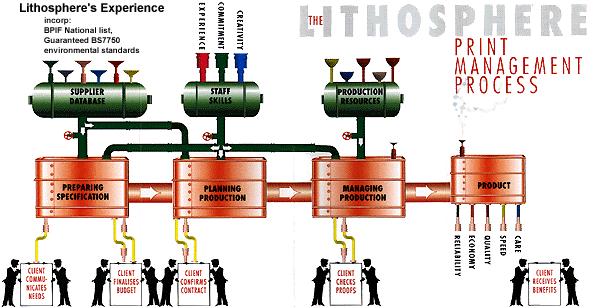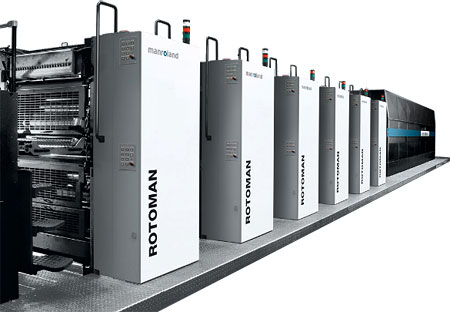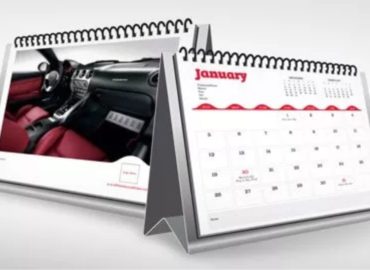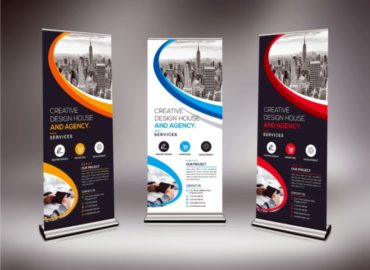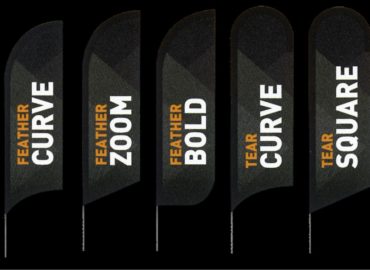The Sky Is The Limit
A report exclusively for Kommando
It’s not an oncoming alien invasion but a mixture of soap, foam, helium and novelty which creates our newest road show offerings that can be of good help to the environment, taking your brand to the skies.
All integrated marketing strategy for brands are gradually boiling down to the fix insight around the brands goal for every year. Going back to our roots said by Kommando … In 1996 they created the world’s first ever “Skyjack” guerrilla stunt for a movie premier using giant laser projections and high-powered searchlights bounced onto low cloud cover, creating the special effects of an oncoming Alien Invasion, a stirring in the skies…

It’s not an oncoming alien invasion but a mixture of soap, foam, helium and novelty which creates their newest Kommando offering in the marketing world, taking your brand to the skies. BLOGOS can be shaped into logos or badges of any shape, created to soar hundreds or thousands of feet.
Their BLOGOS are created using a specialized machine which produces a 3 foot logo/shape at the rate of 1 every 15-20 seconds and the best bit is they are completely biodegradable, dissolving in the sky after a matter of hours.
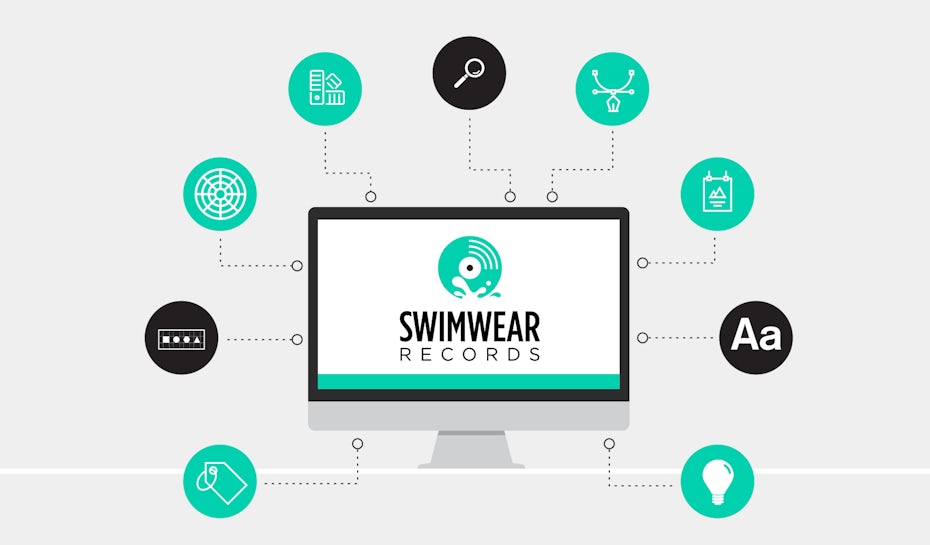
Launched inside, outside or over your main competitors event, we can’t think of anything more exciting than a cheeky BLOGO lifting the heads of everyone around is very important in building a global appeal with the right audience that can benefit from a brands market aim.
Boardwalk Empire Experiential Campaign And Experiential Marketing
An NYC subway is transported back to the 1920’s to promote Boardwalk Empire… which seems to be an amazing idea spanning various location in the world. Through experiential marketing strategy a client can get to the forefront of his market without having to incur cost afterwards. Through Letter Head Printing | Sticker
We love this idea to promote HBO’s Boardwalk Empire; a subway train was replaced with a vintage 1920s train to recreate to mood and atmosphere of the era that the show is set in.
A great experiential campaign if ever we saw one!
Biggest Ever Lipton Iced Tea Sampling
Britvic aims to reach at least 1million UK consumers this summer with its largest ever sampling campaign.
The campaign follows the rapid growth in the value – up 92.7% – of the “cold hot drinks” sector and will be rolled out across nine major UK cities.
Firework displays will illuminate the skies tomorrow while gamers’ screens are lit up by the new zombie video game, Dead Island, which was at the centre of this year’s most talked about and effective video game trailer.
This year, the first trailer for Dead Island caused a stir on the web: The story, told in reverse, of the death of a young girl, through a zombie attack and her parents’ attempt to save her life. The trailer was jaw dropping, raw with emotion, and captured the eyes of millions (over 1 million in the first 24 hours alone) around the world.
Publishers of the game didn’t expect the trailer to receive such a following and coverage through social media channel YouTube. The shocking yet realistic images made entertaining visuals coupled with a gripping soundtrack and daring concept, leaving viewers wanting more and gamers anticipating the release.
The brand used a concept many would be aware of combined with compelling music to create an emotional connection with the viewer. It is no surprise that the original video has had nearly 8 million hits and inspired makers to release other versions. The musical accompaniment proved to be such a hit that the artist gave permission for its release and download on iTunes.
Some critics were worried that the game wouldn’t live up to all its hype but recently this rumor has been squashed as Dead Island entered in at No.1 in the UK Video Game Chart managing to beat off competition and maintain its popularity. Deep Silver used a marketing company to create the initial teaser trailer which was amplified through various social media channels.
The success in the US has sparked a bidding war amongst Hollywood studios eager to get their hands on adaptation rights. Lionsgate recently announced their acquisition of film rights, which they hope to expand to a potential franchise, and had the following to say:
“This is exactly the type of property we’re looking to adapt at Lionsgate: it’s sophisticated, edgy, and a true elevation of a genre that we know and love. It also has built in brand recognition around the world, and franchise potential.”
What a great example of how social media can benefit your brand and getting the right connection with your target market can provide endless opportunities! Maybe this footage could be a contender for Youtube’s Ad of the Year?
Britvic research shows that that when people try Lipton Ice Tea, 80% go on to buy the drink. Jon Evans, head of seed brands at Britvic, says Lipton Ice Tea is set to be “the next Innocent Smoothie” of the drinks sector.
He adds: “We are reinvesting in Lipton Ice Tea every year and this summer’s sampling campaign should reach 3 million people with word of mouth.”
Sampling stations will encourage consumer engagement with the Lipton brand through the game of “knokkers” – a mixture between pool and bowls. The campaign will also be supported by a social media marketing campaign to amplify the message and ensure consumers continue to engage with the campaign even after the summer sampling has finished.
<iframe width=”560″ height=”315″ src=”https://www.youtube.com/embed/lZqrG1bdGtg” frameborder=”0″ allow=”accelerometer; autoplay; encrypted-media; gyroscope; picture-in-picture” allowfullscreen></iframe>
Reverse Graffiti has been doing the rounds for a few years now, yet there is still a grey area over its legality.
Also known as Clean Graffiti, the temporary and environmentally friendly effect is achieved by removing dirt from a surface to create an advertisement. So, can people really be charged for what is effectively cleaning?Many companies have employed this format of advertising with no legal action, yet a Yorkshire Reverse Graffiti artist known as “Moose” was faced with prosecution by Leeds City Council who insisted his work for Smirnoff was illegal because all advertisers need a permit.
In some locations reverse graffiti is against the law, covered by the Town and Country Planning Act 1990, but it can be difficult to find accurate information and research on the internet fails to “clean” up the issue.
These graphic scenes aren’t for the launch of a new movie or reality show. A performance artiste is undergoing animal laboratory tests in the window of Lush Regent Street London, to raise awareness of the worldwide ‘Fighting Animal Testing’ campaign and EU petition.
The stunt is part of a campaign by Lush Cosmetics and The Humane Society.
Hundreds of horrified shoppers watched a young woman endure 10 hours of experiments, being restrained, force-fed and injected with cosmetics in a high street shop window.
Some of the experiments on the model included hair removal, squirting irritants in the eyes, injecting solution via needles and lotions/ creams smeared across the face.
The model appeared genuinely terrified as she was pinned down on a bench and had her mouth stretched open with two metal hooks while a man in a white coat force-fed her until she choked and gagged.
The gruesome spectacle aimed to highlight the cruelty inflicted on animals during cosmetic laboratory tests and raise awareness that animal testing is still a common practise.
The Humane Society International and Lush Cosmetics have joined forces to launch the largest-ever global campaign to end animal testing for cosmetics.
The campaign, launched to coincide with World Week for Animals in Laboratories, is being rolled out simultaneously in over 700 Lush Ltd. shops across forty-seven countries including the United States, Canada, India, Australia, New Zealand, South Korea and Russia.
Lush campaign manager Tamsin Omond commented: “The ironic thing is that if it was a beagle in the window and we were doing all these things to it, we’d have the police and RSPCA here in minutes.
Somewhere in the world, this kind of thing is happening to an animal every few seconds on average. The difference is, it’s normally hidden. We need to remind people it is still going on.”
THE STUNT
In total, 70 ft peace signs have appeared in over ten cities across the UK on behalf of Lynx.
The brands Make Love Not War campaign saw London’s iconic Tower Bridge adorned with a giant peace sign, while further down the river a huge water projection in front of The London Eye created a beacon of peace, shining out for all to see.
Over ten cities including Edinburgh, Manchester, Bristol, Brighton and Sheffield saw the symbol projected onto key iconic buildings.
Jeremy Gilley, founder of Peace One Day, said of the campaign: “Through our partnership with Lynx, we hope to raise awareness in an astonishing amount of young people, and awareness of peace is everything.”
<iframe width=”600″ height=”320″ src=”https://www.youtube.com/embed/YBrX7fBkjv8″ frameborder=”0″ allow=”accelerometer; autoplay; encrypted-media; gyroscope; picture-in-picture” allowfullscreen></iframe>
The stunning display was part of a nationwide publicity campaign called Make Love Not War organised by the deodorant brand, Lynx, which has made use of many of the country’s best known and best loved buildings.
Similar stunts have been organised at other famous buildings across the country, including Leeds Corn Exchange and Glastonbury Festival.
Inspiring a new world peace?
THE STUNT
In total, 70 ft peace signs have appeared in over ten cities across the UK on behalf of Lynx.
The brands Make Love Not War campaign saw London’s iconic Tower Bridge adorned with a giant peace sign, while further down the river a huge water projection in front of The London Eye created a beacon of peace, shining out for all to see
Over ten cities including Edinburgh, Manchester, Bristol, Brighton and Sheffield saw the symbol projected onto key iconic buildings.
Jeremy Gilley, founder of Peace One Day, said of the campaign: “Through our partnership with Lynx, we hope to raise awareness in an astonishing amount of young people, and awareness of peace is everything.”
<iframe width=”600″ height=”320″ src=”https://www.youtube.com/embed/YBrX7fBkjv8″ frameborder=”0″ allow=”accelerometer; autoplay; encrypted-media; gyroscope; picture-in-picture” allowfullscreen></iframe>
The stunning display was part of a nationwide publicity campaign called Make Love Not War organised by the deodorant brand, Lynx, which has made use of many of the country’s best known and best loved buildings.
Similar stunts have been organised at other famous buildings across the country, including Leeds Corn Exchange and Glastonbury Festival.
Responsible Drinking Experiment
Heineken teamed up with DJ Armin van Buuren to undertake a social ‘experiment’ across two separate nights in the same club.
The test, named ‘Dance More, Drink Slow’, was used to demonstrate that a good DJ can encourage people to limit their drinking in order to enjoy the music. The stunt was able to successfully influence the drinking behaviour of revellers.
The beer giant will soon launch its global campaign which encourages drinkers to make the most of their nights out in a responsible way. The campaign message is being amplified through “The Experiment.”
“The Experiment” video accompanied by a new music track, ‘Save My Night’ will also be backed by a series of experiential stunts targeting young adults during their nights out in more than 20 countries.
Heineken’s latest drive is part of an ongoing “responsibility to make moderate drinking aspirational,” (Heineken, 2014) and builds on the brands “Sunrise” campaign, which launched in 2012, to provide a contrast to the negative anti-drinking ads pushed by other companies.
<iframe width=”560″ height=”315″ src=”https://www.youtube.com/embed/WRup4Xk7uKE” frameborder=”0″ allow=”accelerometer; autoplay; encrypted-media; gyroscope; picture-in-picture” allowfullscreen></iframe>
Digital & Social Media
In a world where attention is the holy grail for marketers – where online engagement and social media chatter are the new return on investment – it’s vital to connect Brand Experiences to the digital landscape for amplification and measurement..
By understanding the full spectrum of social media channels available, we tailor authentic, targeted and memorable brand experiences for your consumers.
DIGITAL EXPERIENTIAL MARKETING
With so many elements that make up an effective digital Experiential strategy, sometimes it can be difficult to keep up. That’s where we come in.
We combine Experiential Marketing techniques and Technology to bring digitally connected audiences together through the power of digital.
SOCIAL MEDIA
Explosive Thinking To Grow Your Brand!
We know how to turn your event into a fully discoverable social machine. Ultimately, it is about amplifying your brand message by keeping the conversation going!
We can even throw in some out-of-the-box thinking to ensure you get the best exposure possible in a landscape where originality thrives.
BRINGING BRANDS TO LIFE
77% of marketers use experiential marketing as a vital part of a brand’s advertising strategies.
LIMITLESS POSSIBILITIES
Authentic and immersive brand experiences, give consumers a better ‘feeling’ for the brand. Utilising the senses to engage audiences can emotionally define it from it’s competitors. Building that exciting feeling around your brand story is what we do.
Our creativity and immersive experiential event technology, provide the elements of surpirse and delight, bringing people and brands closer together.
For the best Experiential Marketing results, you need the most experienced team.
Product Sampling
Understanding the myriad of challenges that come with nationwide product sampling is a skill, perfected over time and through experience.
Since 2000 our team of product sampling expertshave planned, moved and distributed an estimated 8 million product samples accross the UK with military precision.
Highly effective and results orientated, our product sampling delivers results.
GET YOUR PRODUCTS OUT THERE
GET YOUR PRODUCTS OUT THERE
We provide effective planning, tools and resource that drive hassle-free product sampling across the UK. Mobilising samples safely to the frontline and into the hands of any target audience where they are most responsive…It’s what we do. We treat each product sample as valuable currency, ensuring that it’s not just received as a “freebie” but a powerful marketing trigger that generates the highest possible returns for our clients
WE’LL TAKE CARE OF EVERYTHING
We’ve been providing all manner of product sampling services to clients for 18 years. Whether you require food, & drink sampling, in store, city centre or festival sampling, we have the support staff and experience to pull it off. Rest assured that your product sampling campaign and reputation is in the safest hands with Kommando.
- UK wide coverage
- Fast Turnaround
- Guaranteed customer engagement
- We’ll plan and enact your campaign
- All quotes free of charge
- We’re the go to agency for big brands
Promotional Staffing
Our vast experience in the industry, and having a network of 3000+ staff means you can rely on Kommando to get the job done.
Whether you need 1 member of staff or 100 across the entire UK, we can fulfil all of your staffing requirements.
Leading the industry through innovative technology that improves staffing efficiency and client satisfaction is what makes us one of the leading promotional staffing agencies. Our Klockwork Staffing System really pays dividends and our military precision becomes Kommando’s watchword. We apply that same rigour to each and every campaign the length and breadth of the country.
KLOCKWORKTM
All of our staffing and sampling projects are underpinned by Klockwork™, our unique field force process which recruits, monitors, evaluates & mobilises.
You can rely on our promotional ambassadors to complete the project efficiently and effectively. We understand that sourcing the right face and personality for your brand and campaign is top priority. Get in touch with us.
At the XINI all our hopes is to to become your campaign marketing partner for your successful political campaign.
The Apple Experience
A new report from the Wall Street Journal reveals details of just how seriously Apple takes its consumer experience.From the way the employees speak to people to the more minor details such as the security cables holding the products to the tables, every last factor has been engineered to give the best possible consumer experience.
SOME OF THE DETAILS ARE:
To put a positive spin on bad news, employees at the Genius Bar are asked to say “as it turns out” rather than “unfortunately”.New employees are forbidden to talk to customers and instead shadow more experience colleagues until they are ready – often taking a few weeks or more.To keep things busy its common for Genius appointments to be triple booked.
With Apple’s sales per square foot now at $4,406 (higher than luxury jeweller Tiffany’s and Co) they must be getting something right.
LOCOGs on Mobile Marketing
Are LOCOGs efforts to control mobile marketing wasted?
The news that LOCOG is aiming to prevent non-sponsors from using virtual space surrounding the Olympics by making official location based check-in available only to sponsors has sparked some debate in Kommando HQ.
LOCOG plans to take advantage of Foursquare by offering a range of check-in points relevant to the Games. A deal with Foursquare could not be confirmed as yet but they are in talks to offer official check-in platforms open only to sponsors.
A spokesman for LOCOG said ‘We will be working with a range of location-based services at Games-time on a non-exclusive basis. We will announce more details in due course.’
Following the warning from digital experts that there will be a barrage of social media marketing ahead of London 2012 we wonder if LOCOGs efforts will be wasted due to the other opportunities available for non-sponsors to get in on the act.
If social media can bring down governments and change regimes then how much of a chance does LOCOG have of controlling and managing social media in and around the Games? Which brings us to the point that if you want to reach and target this audience but don’t have the privilege of being an official sponsor, mobile, digital and social coupled with guerrilla tactics is your best option!
Ariel Fashion Shoot

This is a fun experiential marketing campaign with a nice social media tie in from Ariel…
Appearing for one week (from 29th August – 3rd September) a specially built glass box was constructed in the waiting hall of Stockholm Central Station. Passers by could watch as clothes, which were hung on a washing line, moved around the box and were hit with ketchup, drinking chocolate and lingonberry jam.
The clever part becomes clear when it is revealed that the industrial robot responsible for firing the condiments is controlled by Facebook users, in real time. Participants who visited the bespoke custom Facebook page were invited to aim, stain and win whatever they hit. The stained garment was then sent to the player once it was washed on-site with Ariel Actilift.
<iframe width=”560″ height=”315″ src=”https://www.youtube.com/embed/ly5cdIRzYD4″ frameborder=”0″ allow=”accelerometer; autoplay; encrypted-media; gyroscope; picture-in-picture” allowfullscreen></iframe>
Crop Art
Take a closer look at the images below and you’ll notice that this is not just painted, ink stained grass or a large image placed in a field, it is the result of months of planning and precise execution. It is Large Scale Crop Art.
Also known as landscape art and is essentially coloured rice crops which can only be seen from an Ariel view and take months to grow. The canvas is the size of the fields that it occupies.Images are created on large areas of land, beginning with planning and design commencing many months in advance. Planting, mowing and on occasions burning or plowing is carried out in the latter stages.
Crop Art used by marketers falls under Guerrilla Marketing because these creations make for engaging experiences, generating buzz and publicity. The artistic Guerrilla stunt uses experts in the field (literally), who are equip with the relevant knowledge and use highly specialised techniques and tools. They Crop Art also utilises highly specialised equipment and intelligent ideas and design.
The impressive photos and video above display ‘murals’ grown by farmers in Japan, Inakadate, using different coloured rice plants. The crops were produced in summer months after they had a chance to grow and are created by planting purple and yellow-leafed kodaimai rice along with their local green-leafed tsugaru roman variety.
These japanese pieces of art cover 15,000 square metres and anyone interested in seeing it either can view it from the air or locals can climb the village’s castle tower.
Using computers, farmers can draw the design and calculate a precise layout and plan for planting rice. Many coloured variations of rice were used for this particular project and the village’s Crop Art attracts more than 15,000 visitors to the area every summer (Inakadate is only home to around 8,700 people).
Creating enormous images and placing them upon the earth is not novel. The Nazca people of ancient Peru created vast geoglyphs of animals and geometric shapes by scratching lines into the Earth’s surface as did other ancient peoples.
Crop Art is a creative Guerrilla Marketing technique which has inspired many brands and musicians to produce similar large scale artwork on areas of land, across the world. Although these imitations of Crop Art use less specialised techniques and equipment they still make impressive Guerrilla Marketing stunts. See ‘The Streets’ creation within the images above.
What Does Virtual Reality Feel Like?

In the video below a consumer decides to take part in virtual reality. He soon shows spectators how real the experience can feel.
The man enters a world of virtual reality through a specialised headset and headphones attached to a computer system running the virtual reality program. He finds himself hundreds of meters above a city riding what looks like the scariest rollercoaster in the world but he is then pushed by a friend as he endures the first plummet.
<iframe width=”600″ height=”320″ src=”https://www.youtube.com/embed/Odax7F3tWhM” frameborder=”0″ allow=”accelerometer; autoplay; encrypted-media; gyroscope; picture-in-picture” allowfullscreen></iframe>
Remember when Volkswagen cleverly used Star Wars for their Super Bowl commercial? After achieving great success with this memorable advert they have created another attention grabbing ad for the 2012 Super Bowl.
So far VW’s post has generated: 62,830 likes and been viewed by 9,316,007.
This year’s Super Bowl sees New York Giants compete against New England Patriots and Volkswagen is bringing Star Wars back into the limelight for their big Super Bowl spot. The brand has released a teaser commercial which features a ‘canine choir’ centre stage and barking a familiar tune. The teaser has been named “The Bark Side 2012 Volkswagen Super Bowl Commercial Teaser” and the barks follow the melody of ‘The Imperial March’ from The Empire Strikes Back. Aside from singing the canines are quite amusing to watch while they are on the set, a set which has been created to resemble the Rebel Blockade Runner that Princess Leia used to escape from the Empire with the Death Star plans.
Some of the dogs have been transformed into Star Wars characters and dressed as Wicket the Ewok, Chewbacca, Princess Leia, and lastly the great Darth Vader.
Volkswagen has said ‘The Bark Side’ will air during the Super Bowl on Sunday, February 5.
Volkswagen have commented about the release of the video: “A canine chorus barks a familiar tune. Keep an eye out for our 2012 Game Day commercial—it will all make sense. Love Star Wars and Volkswagen?

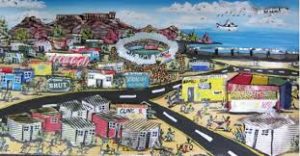
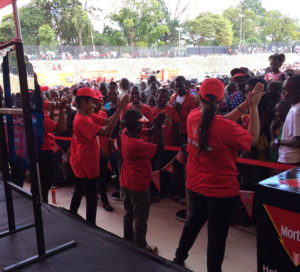


NEXT
Local Printing To Digital Printing Steps
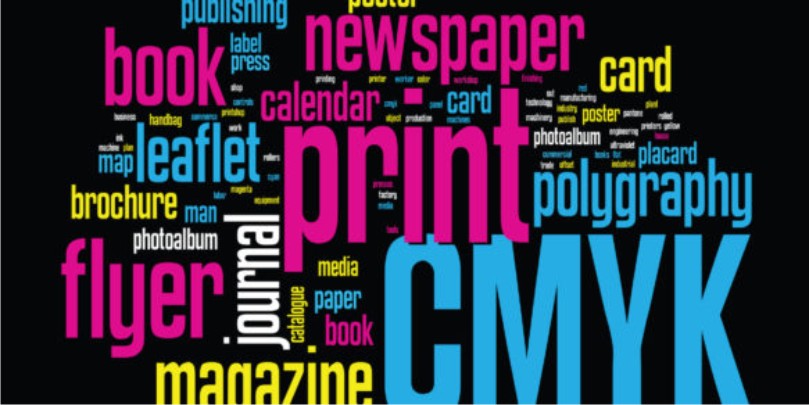
Local Printing To Digital Printing Steps
Printing: The main brand purpose of this article is to help you understand how detailed and complex the print process truly is, and the value of working with someone who has the expertise to ensure your job is handled correctly. There is an enormous difference between a quality print job and simply sending your files to a local franchise print shop. Today, we open the doors of our Art/Production Department to give you an exclusive behind-the-scenes tour of what the print process looks like at ![]() .
.
Series 1 Exposition
Graphic Design
Graphic design is defined as the arrangement of type and visual elements along with specifications for paper, ink colors, and printing processes that, when combined, convey a visual message.[1] The graphic design stage includes concepting, page layout, typography, illustration, photography selection, color decisions, and producing final computer files.
Note: While it is tempting to hire a freelance graphic designer to create materials that can be sent directly to a low-cost printer, not all graphic designers know how to properly prepare files for printing. Once a design is approved, the files must be “packaged”. Unless the graphic designer is trained in production management, the odds increase substantially for a less than satisfactory print job. The reasons vary from missing fonts and/or images, to the use of incompatible software, for example. This generates delays, cost overruns, unanticipated proofing rounds, late-stage design changes, and sometimes disappointment over the finished job. Meticulous attention to detail at each step of the process is necessary to avoid these kinds of issues.
Creation of artwork – Important facts
Creating artwork requires taking multiple factors into account. Here are some of the most important elements to consider:
Art must be prepared in the software that is best suited for the particular task, and in a version that is compatible with the selected print shop. If the print shop uses a newer or older version than what the art file was created with, you can run into problems. Some of the industry’s standard applications include: Illustrator, a drawing program to create logos or illustration; Photoshop, a pixel-based program to manipulate photos; and In Design, a page layout program to create a single or multi-page document.
Accurate layout
Usually, files need to be built at actual size and use bleed space when appropriate. (This eliminates room for errors with the printing estimate and final printed result). If a file is not built correctly, the printer will have to spend time (and therefore charge you a fee) to readjust files to fit the correct specifications of the job.
Approved fonts
The fonts should be consistent with your brand standard and must be included with the files sent to the printer. If the printer does not have the font used in the artwork, and it has not been included with the packaged files, the printer may simply choose to substitute the fonts, producing something that is probably similar but not what you actually approved.
Suitable image resolution
Images need to be high-resolution and large enough to fit within the assigned space. The resolution should be 300 dpi (dots per inch). Anything smaller than that might result in a loss of quality.
Precise color
As with the fonts, the colors and general tone of the piece should be consistent with your brand. That said, never trust the colors of a piece being designed on a computer as the actual colors that will turn out once printed! The reason is because a computer screen and paper printing use 2 different types of processes, RGB and CMYK, to create actual colors:
- RGB (Red, Green, Blue) is an “additive coloration” mode. Think of a computer screen with a black background. In order to see the colors, some lights of red, green, and blue are “added” to the black background. RGB is typically used to render colors on monitors and computer screens.
- CMYK (Cyan, Magenta, Yellow, Black) is a “subtractive coloration” mode. It is intended to be applied to print on white or colored paper, and calculates the correct hues by “subtracting” from the initial brightness of the paper. The CMYK coloration mode is intended for use in paper printing applications and printing specific, exact colors.
CMYK is also referred to as “process colors,” which is different than spot colors (also called PMS – Pantone Matching System). CMYK uses four different color inks (Cyan, Magenta, Yellow, and Black) overlapping each other to achieve the full color spectrum. To print any multicolor image, the same four color inks are used. The press runs four imes to apply each ink individually.
Spot colors are pre-mixed inks that are applied only to the area assigned for each particular color. For example, to print a blue, brown, and red image, pre-mixed blue, brown, and red inks are used. In this case, the printing press runs only three times, which reduces printing costs. Click here to read more about spot colors.
We work on-site with the printer to ensure that the final printed product matches your brand colors as closely as possible and we advise on color corrections along the way if necessary.
File naming
Files must be named to allow printers to work more efficiently. For example, make sure there are no unusual characters in the file’s name or it may cause a printer’s computer to crash. They should be labeled with the correct extension: .ai for Illustrator, .indd for InDesign, digital marketing etc. Perhaps this sounds elementary to some, but we have learned that this simple step significantly expedites the process.
File preparation to release for print
Before the artwork can be sent to the printer, here are a few steps we use to ensure the files are prepared correctly:
- Use of preflight software: Preflight software helps collect all the fonts and images, search for missing items, and avoid mistakes.
- Verification of page size settings and bleeds : Incorrect page settings cannot be fixed by simply scaling up or down, so make sure the document size is the final trim size. Bleed photos and other graphics that extend to the edge of a page must be set up to overlap the trim margins by an 1/8th inch to avoid white along the edge.
- File cleanup: Cluttered files not only confuse and frustrate printers, they compound the possibility of errors. Make sure to remove unnecessary artwork, delete unused colors, and verify that all the color names match exactly across all programs. An oversight such as not specifying whether a color is CMYK or PMS (or spot colors) might change the overall colors of a piece or even turn a four-color job into a more expensive five-color job by mistake.
The Quote Process – Communication with vendors is key
We always communicate with our vendors early in the process and negotiate the best prices for our clients without sacrificing quality. We discuss topics covering the purpose of the materials we will be printing, the final size, the quantity needed, the deadline, etc. All of this information is essential to determine the best type of press to be used (digital or offset), schedule press time, order paper, etc. Here are some of the elements we take into consideration:
- Size: dimensions of the piece (flat and final size)
- Stock: weight, finish, grade name, and color of the paper
- Inks: number and types of inks and varnishes (four-color process, PMS colors)
- Bleed: an 1/8th inch extension to the edge of a page
- Proofs: review of PDF and hard-copy versions
- File format: this information is very important to make sure the print shop can support our software/application and can open the files
- Finishing: type of trim, score, fold, assembly, and seal if applicable
- Printing and mailing or shipping date: this step is very important to determine which vendor and what kind of budget best suits the project
Prepress and the proofing process
Prepress refers to all the print production functions that take place from the moment the files are sent to the printer to the actual printing. These functions might include some of the following: receiving media files, creating proofs for review and approval, making any final changes/edits, creating the plates for the offset press, etc. At XINI, we use a 3-step final proofing process:
- Step 1: PDF proof (review copy/elements/fonts) – We request a PDF proof of the artwork from our vendors. This allows us to proofread the content one last time and make sure the piece contains no mistakes. It also lets us make sure the text hasn’t shifted or the images haven’t moved while the printer processed the files.
- Step 2: Hard-copy proof (review color match/paper) – We then receive a hard-copy printout, which lets us see the final document, check for discrepancies, and clarify how the layout is intended to look.
- Step 3: On-location press-check – Upon approval of the hard-copy proof, we go to the print shop for a final press-check in order to approve the paper, inks, varnishes, colors, etc.
Printing (offset vs. digital)
Printing is the mechanical process of applying ink to paper using an offset or digital press. The offset press is the most cost effective way of producing large volumes of printed materials, while the digital press is more commonly used for smaller volume and lower production cost. It is important to understand that the final product will look slightly different when printed digitally vs. offset, as well as from printer to printer. Proper and consistent paper selection is also a critical component of the process because color appears distinctively on different paper stocks and with or without finishes (varnish, aqueous coating, etc.). So when you need to reprint, it is best to use the same methodology, on the same paper, with the same finishes, at the same printer to match the original run as closely as possible. As part of our service, we have skilled production managers who oversee the process to ensure great and consistent outcomes.
Bindery/Finish
After a job is printed, the next stage includes one or many steps depending on the end product: cutting/trimming, folding, laminating, scoring, perforating, stitching, and binding. The last step in the bindery stage includes packaging for delivery.
Delivery
Most jobs are shipped to our clients directly or delivered to a specialized facility called a mail-house or “letter-shop” when materials are to be mailed on behalf of the client. In this stage, the addresses are computer-imprinted from the customer’s mailing list database onto the printed piece, then sorted and prepared for delivery to the post office.
As you can see, the print production process is very detailed and requires a certain level of experience and expertise. Most importantly, at ![]() , we monitor the jobs in person, from start to finish, to ensure that the highest standards are met, your brand is represented through quality materials, and that you always receive the utmost value for your investment.
, we monitor the jobs in person, from start to finish, to ensure that the highest standards are met, your brand is represented through quality materials, and that you always receive the utmost value for your investment.
Series 2 Exposition
Book production
Book production is a complex process that begins with detailed planning. Together with the printer, the paper, printing process and number of copies are specified; then, together with the graphic designer, the cover, binding and layout are developed. The prepress process concerns itself with the print data to ensure that the finished printed book should correspond exactly to your conception.
It is vital in book production for there to be a seamless interlinking of processes, know-how and commitment on the part of all XINI employees and a constant control of individual work procedures, which requires teamwork at all levels.
Book production – the way to your book begins with the book design
The manuscript is finished: now you want to see the book in print. As the author, publisher or client you may already have a concrete idea of how the book is to look. Our specialists help you realise your ideas for book design. They know which layout, cover and configuration is right for your book and will appeal to readers.
The cover is an important publicity and information medium: it is designed at XINI Prints by experienced graphic designers. The book cover represents the first visible reference to the book in any advertising effort as well as the first contact between the reader and the book, conveying far more than simply the author’s name and title. If you wish to have books printed, we will be pleased to offer you comprehensive advice on the design of the book cover as well as on the choice of the correct format, binding and paper.
Prepress and planning – your book goes to print
The individual steps in the production of a book are closely connected at LONGO. Smooth collaboration between our various departments, from pre-press to print logistics, is a major factor contributing to our high print quality, punctual delivery and costing accuracy.
Small and mini print runs are perfectly suited to digital printing, thanks to digital printing, book production is now an affordable, costable option, and not just for self publishers. If a large print run is required, the speed and precision of offset printing make it the appropriate process.

After the book has been printed it must be bound. The raw printed sheets come from the printworks and are folded, bound, cut and provided with a binding. Whether for threadless binding or thread stitching, a book for the mass-market or the coffee-table, we can also comprehensively advise you on this production step.
Books are frequently shrink-wrapped in plastic foil and bundled with booklets or magazines, and thus prepared for dispatch. We also support you in all the steps that follow the print run!
The end of the book production process results in what the XINI team always delighted to hold in their hands: a finished book! Contact us for more details. or send an email to info@xinicomms.com for our ![]() quote or simply call 07082709871, 07015883269 today.
quote or simply call 07082709871, 07015883269 today.
Going forward, We Have The Multi Step Printing Exposition
We have mentioned that printing is both a dirty business and one in which “printers” use the technical nature of the process to extract extra costs. Lithosphere’s philosophy has always been to be very open about processes and costs involved. Clearly defining the roles, input and expectations of all the parties concerned.
The following diagram and list of pre-press, printing and finishing process serves to demonstrate our commitment to smoothly fulfilling our clients expectations and our experience in managing all aspects of the print production process.
The Process in detail
Pre-press index:
|
|
|
Printing process:
|
|
|
Finishing index:
|
|
|
All of the multi step as supplied by Lithosphere may look simple but the professionalism required is more complicated than any activity in any industry but thanks to our super team put clear structure in the print/ printing communications industry in Lagos, Nigeria with super creative and innovative concept put in place.
Printing Steps
There are a wide variety of technologies that are used to print stuff. The main industrial printing processes are:
- Offset lithography
- Flexography
- Digital printing: inkjet & xerography
- Gravure
- Screen printing
Additional printing techniques were developed for very specific applications. These include flock printing, letterpress, intaglio, pad printing, and thermography.
Why a certain job is better printed using one of these processes mentioned can be read on this page about choosing a printing process.
Offset
Prepressure explained to there team that In offset lithography a printing plate, which is most often made from aluminum, contains an image of the content that needs to be printed. When the plate is inked, only this image part holds ink. That inked image is subsequently transferred (or offset) from the plate to a rubber blanket and then to the printing surface. The process can be used to print on paper, cardboard, plastic or other materials, but these have to have a flat surface.
Below is a picture of a 4 color sheetfed printing press. At the far end is the intake where individual sheets of paper are automatically fed into the press. The 4 towers or printing units each print one color, typically black get printedfirst, followed by cyan, magenta and yellow. The stack of printed sheets is visible on the front of the machine, underneath the press console & monitor which the press operator uses to control the press.
For higher volume work offset presses use rolls of paper. The picture below shows such a much larger web press. It is so fast that the printed paper needs to be force dried. The black unit at the end of the press is an oven.
Offset is nowadays the most widely used printing technique for an extensive range of products such as books, newspapers, stationery, corrugated board, posters, etc.
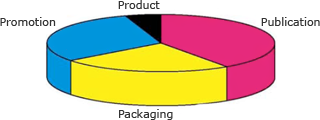 There is a trend that printing promotional material is gradually migrating to digital printing while some packaging printing is moving to flexo.
There is a trend that printing promotional material is gradually migrating to digital printing while some packaging printing is moving to flexo.
You can find more information on the page dedicated to offset printing.
Flexo
In flexography the content that needs to be printed is on a relief of a printing plate, which is made from rubber. This plate is inked and that inked image is subsequently transferred to the printing surface. The process can be used to print on paper as well as plastics, metals, cellophane and other materials. Flexo is mainly used for packaging and labels and to a lesser extent also for newspapers.
 Some packaging printing is moving from flexo to digital.
Some packaging printing is moving from flexo to digital.
Digital printing
Digital printing can be done in various ways. Two technologies dominate the industry:
- Inkjet – In an inkjet printer the image that needs to be printed is created by small droplets of ink that are propelled from the nozzles of one or more print heads. Inkjet devices can print on a wide range of substrates such as paper, plastic, canvas or even doors and floor tiles. Inkjet printing is used a lot for posters and signage. It is also economical for short run publications such as photo books or small runs of books. In-line inkjet printers are sometimes combined with other types of presses to print variable data, such as the mailing addresses on direct mail pieces. The press shown below is the HP PageWide C500, meant for printing on corrugated board.

- Xerography – In xerographic printers, such as laser printers, the image that needs to be printed is formed by selectively applying a charge to a metal cylinder called a drum. The electrical charge is used to attract toner particles. These particles are transferred to the media that is being printed on. To make sure the toner is fixed properly, the substrate passes through a fuser that melts the toner into the medium. Laser printers are not only used in offices but also for small run printing of books, brochures and other types of document. These printers are also used for transactional printing (bills, bank documents, etc) and direct mail.
In 2009 both techniques jointly accounted for around 15% of the total volume of print.
 Digital printing is increasingly utilized for print jobs that were previously printing using offset, flexo or screen printing.
Digital printing is increasingly utilized for print jobs that were previously printing using offset, flexo or screen printing.
- In short run small format (A3 size) printing, digital is taking over from offset for both color and B&W printing. Quick printers and copy shops print digitally on presses from vendors like Xerox, HP, Canon, and Konica Minolta.
- Labels are also increasingly being printed digitally.
- Billboard and point-of-sale or point-of-purchase jobs are being done by wide-format inkjet devices.
- There is a wide range of small format printers used to print on phone cases, mugs and other products.
- In book printing publishing companies start to rely more on print-on-demand. The Espresso Book Machine pictured below is well suited for that job.
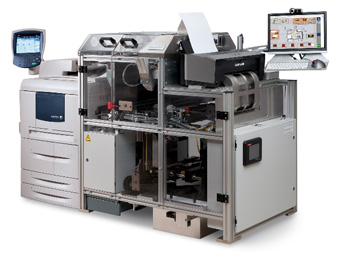
There are a number of other digital printing processes that are geared towards specific niche markets:
- Dye-sublimation is a printing process in which heat is used to transfer a dye onto the substrate. Dye-sub printers are mainly used for printing on textiles, for proofing and for producing photographic prints. Some printers can print on a variety of materials such as paper, plastic, and fabric.
- In the direct thermal printing process heat is used to change the color of a special coating that has been applied to paper. This process is used in cash registers but also to add markings, such as serial numbers, to products. For this a transparent ink is used that changes color when a laser applies heat to it.
- In the thermal ink transfer printing process heat is used to melt print off a ribbon and onto the substrate. It is used in some proofing devices but seems to be gradually disappearing off the market.
Gravure
Also known as rotogravure, this is a technique in which an image is engraved into a printing cylinder. That cylinder is inked and this ink subsequently transfers to the paper. Gravure is used for high volume work such as newspapers, magazines, and packaging.
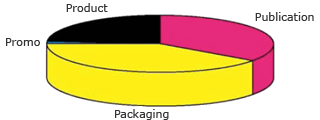 Gravure is gradually losing market share to offset for publication printing and to flexo for packaging applications.
Gravure is gradually losing market share to offset for publication printing and to flexo for packaging applications.
Screen printing
As its name implies, this printing technique relies on a screen, which is a woven piece of fabric. Certain areas of this mesh are coated with a non-permeable material. In the remaining open spaces ink can be pushed through the mesh onto a substrate. The advantage of screen printing is that the surface of the recipient does not have to be flat and that the ink can adhere to a wide range of materials, such as paper, textiles, glass, ceramics, wood, and metal.
The image below shows a screen printing press that is used to print t-shirts.
 Increasingly screen printing is being replaced by digital printing.
Increasingly screen printing is being replaced by digital printing.
Additional printing processes
- Letterpress – Once a dominant printing technique, letterpress is now used for business cards, wedding invitations,…
- Flocking – used to add a (colored) velvet-like texture to paper, textiles, etc.
- Pad printing – used to print on 3-dimensional surfaces.
- Intaglio – nowadays mainly used for used stamps and paper currency.
- Thermography – This is more of a finishing process than an actual printing process. It produces raised lettering on the printed side of the paper and is used for wedding invitations, letterheads, business cards,…
Read about
Best Digital Branding Printing Arrangements To Know
Brochure – Magazine Printing
Feel Free To Always Contact Us Here At Our Head Office In Lagos, Nigeria.



